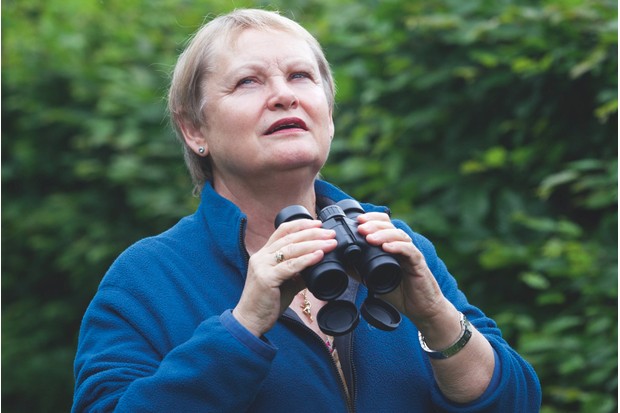After more than 20 years without a sighting, one of the world’s rarest birds – the Jerdon’s courser – was feared extinct. This nocturnal, ground-dwelling species is known only from a small area in south-east India, but when it vanished from records in 2004, it was presumed lost.
That changed dramatically in August 2025, when a group of dedicated birdwatchers made it their mission to find it – and they succeeded.
Rediscovering the Jerdon’s courser
The Jerdon’s courser (Rhinoptilus bitorquatus) is a medium-sized bird, measuring about 27cm (10in) in height. It has a slender build, large eyes, long legs, brown upper body and pale underparts, with distinctive black and white bands across its head, throat and upper breast.
The bird was first described for science in 1848 by British physician and ornithologist, Thomas C Jerdon. He spent many years observing and recording the birdlife of India, having been dispatched there by the East India Company to deal with fever and dysentery amongst the British troops. He found the courser that took his name in Kadapa, Andhra Pradesh province.
All records of the bird then stopped in 1900 and for 86 years it was thought to be extinct due to the loss of its favoured scrub habitat to agriculture.
All records of the bird then stopped in 1900 and for 86 years it was thought to be extinct.
Then, in 1986, it was rediscovered by a local trapper in the area that is now the Sri Lankamalleswara Wildlife Sanctuary in Kadapa. The sanctuary was created largely because it was the only known home of the bird, but observations were minimal and ceased altogether in 2004.
Harish Thangaraj, a keen birdwatcher who runs a birding blog, read about the courser in the online writings of zoologist Dr P Jeganathan. He had been the last person to find any trace of it during a four-year study trip to the sanctuary between 2004 and 2008. Jeganathan had written: “You need a lunatic who’s ready to be frustrated to find it again.”
This was a challenge Thangaraj could not ignore. He assembled a team of like-minded ornothologists, Adesh Shivkar, Ronith Urs, Shashank Dalvi and his friend Pranav, and together they researched the species in depth and sought out other locations with similar scrubland habitat to Sri Lankamalleswara.
They looked for as many recorded sightings as they could find between 1986 and 1994, hoping the bird had widened its range beyond the sanctuary where it could no longer be found.

Their research took two months, in July and August 2025, and culminated in a field trip during the final week of August. Armed with two types of cameras, parabola and multiple sound recorders, head torches, a wildlife flashlight and pepper spray to deal with sloth bears should they encounter an aggressive one, they set out on foot in daylight to scope out the area they had selected as the most likely habitat. They intended to return at sundown for a night’s birding if it looked promising.
Just before 3.00pm, Thangaraj accidentally startled a bird hiding under a dense bush. From his brief glimpse of its size, the look of its back as it flew away and its flight pattern, he was fairly sure it had been their quarry. After a brief pause for something to eat they renewed their search at sundown. Thangaraj was using the Merlin bird call app on his phone to record continually, intending to assemble the parabolic recorder if they positively identified a courser call.
At 9.35pm, a mere day after setting off on their quest, the team heard and recorded the bird on the Merlin app. It was heard in the last 30 seconds of a 1 hour 55 min recording.
The following day they recorded clearer calls and in what remained of their time in Andhra Pradesh they heard the Jerdon’s courser briefly several more times but were not lucky in getting a physical sighting or any photographs.
Nevertheless, the dogged perseverance and in-depth research of the group of friends has put the Jerdon’s courser back on the list of critically endangered birds, rather than extinct ones. And they have every intention of returning to get those precious images of a bird everyone thought was lost forever.
Acknowledging the efforts of the team, Alex Berryman, Senior Red List Officer at Birdlife International says: “Congratulations are due to all involved; this is an incredibly exciting rediscovery and one of the most sought-after lost birds. Finding and documenting lost birds is the obvious first step in implementing action to conserve them. Hopefully, additional search efforts (and some photos!) will follow so that we can better understand the Jerdon’s courser and what might be needed to save it from extinction.”
For more information on the Jerdon’s courser and the Search for Lost Birds collaboration between Birdlife International, American Bird Conservancy and Re:wild, go to the Search for Lost Birds website.
More amazing wildlife stories from around the world
- India's deadliest snakes to become even more dangerous, new study suggests
- There's a bird in Africa that kills nestlings and then throws them out of trees – and researchers have no idea why
- In the 1970s, scientists noticed that trees in a US mountain range were migrating. Now they know why
- In 2020, humans suddenly vanished from a popular bay in Hawai‘i. What happened next was remarkable





